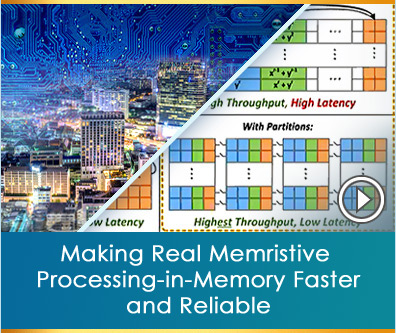 Logic with Memristors
Logic with Memristors
At ASIC2, we are tackling the fundamental memory-wall bottleneck by proposing a redesigned computer architecture that enables true in-memory processing by exploiting physical devices that are inherently capable of both information storage and logic. At the core of this emerging architecture is the memristive Memory Processing Unit (mMPU) [1] that enables computation within the computer memory itself, thereby diminishing the need for data-transfer across the computer.

While processing-in-memory (PIM) has been theorised for decades, the mMPU is rapidly emerging as a practical form of PIM since it has one key element that was previously missing: the memristor. This emerging physical device has already been demonstrated to support information storage (i.e., memory) and is already deployed in commercial memories. Furthermore, logic via memristors has been experimentally demonstrated by our group through the Memristor Aided Logic (MAGIC [2-4]) technique. Together, this provides computational capabilities to the same physical devices that construct the computer memory, enabling true in-memory processing.
As the integration of the mMPU with modern computing systems leads to new challenges and opportunities at many different abstraction levels, our research group is simultaneously developing the technology from several aspects:
[1] S. Kvatinsky, “Making Real Memristive Processing-in-Memory Faster and Reliable”, Proceedings of the International Cellular Nanoscale Networks and their Applications, pp. 1-3, October 2021
[2] S. Kvatinsky, D. Belousov, S. Liman, G. Satat, N. Wald, E. G. Friedman, A. Kolodny, and U. C. Weiser, “MAGIC – Memristor Aided LoGIC”, IEEE Transactions on Circuits and Systems II: Express Briefs, Vol. 61, No. 11, pp. 895- 899, November 2014
[3] B. Hoffer, V. Rana, S. Menzel R. Waser, and S. Kvatinsky, “Experimental Demonstration of Memristor-Aided Logic (MAGIC) Using Valence Change Memory (VCM)”, IEEE Transactions on Electron Devices, Vol. 67, pp. 3115-3122, August 2020
[4] B. Hoffer, N. Wainstein, C. M. Neumann, E. Pop, E. Yalon, and S. Kvatinsky, “Stateful Logic using Phase Change Memory”, IEEE Journal of Exploratory Solid-State Computational Devices and Circuits Transactions on Electronic Devices, Vol. 8, No. 2, pp. 77-83, December 2022
This research is funded by the European Research Council starting grant and by the Israel Science Foundation.
